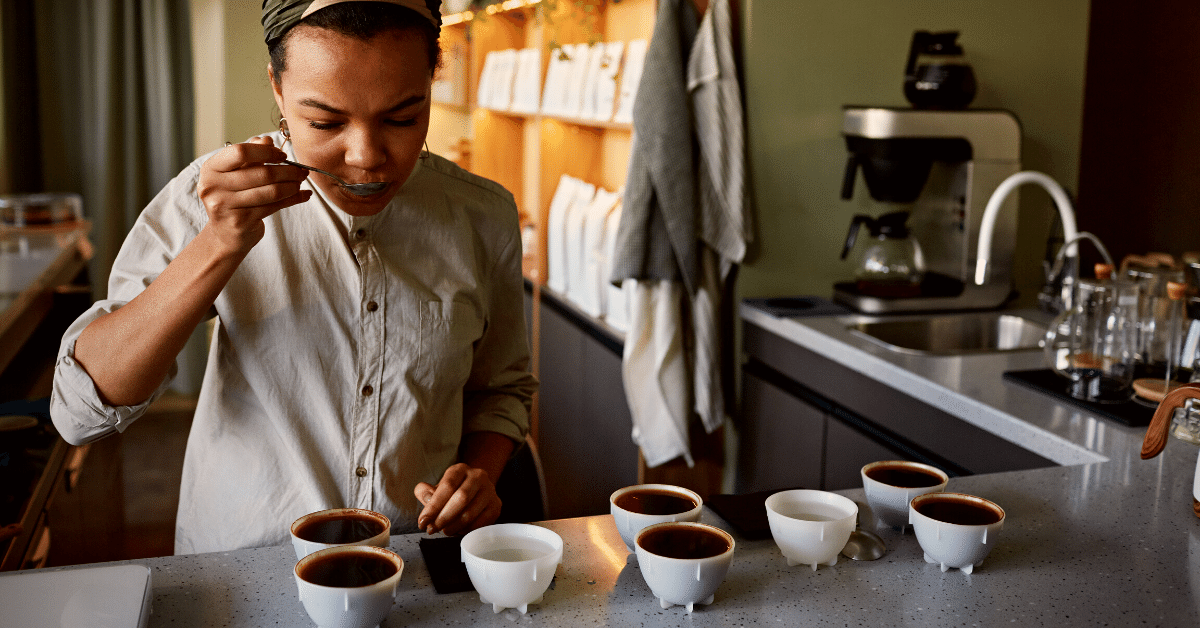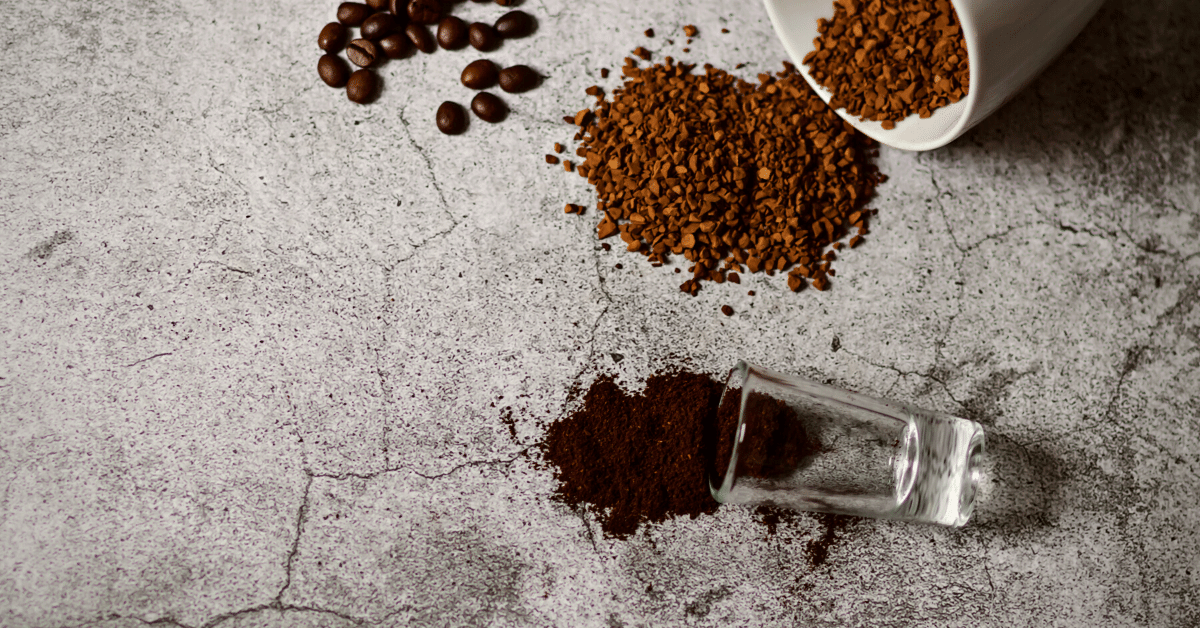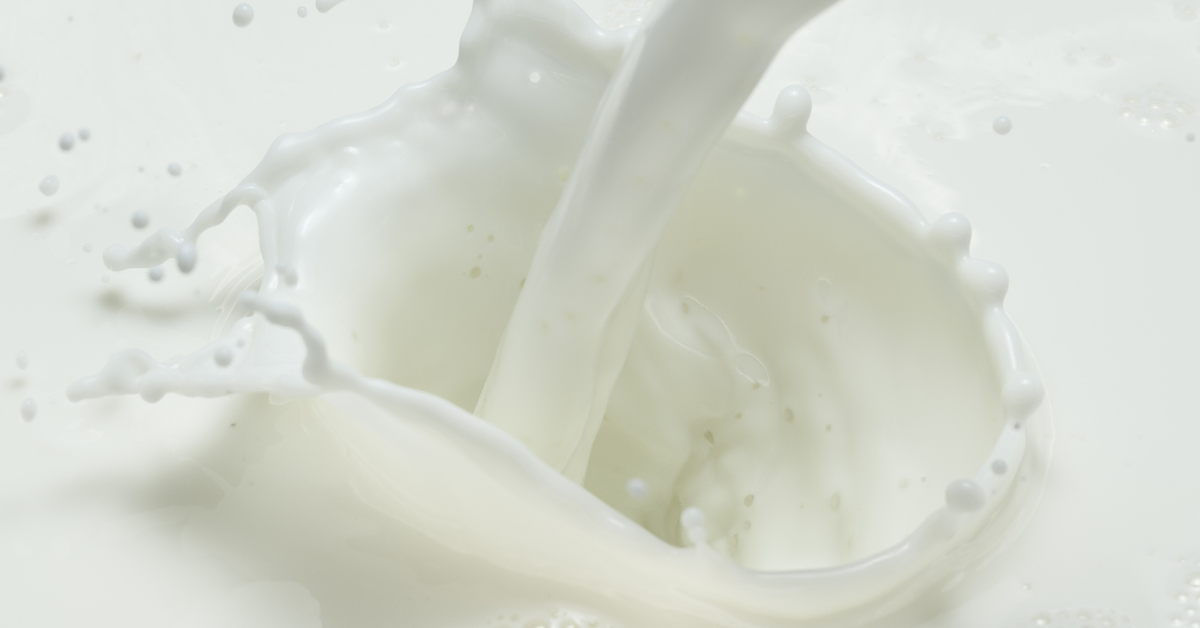Do you want to elevate your coffee tasting skills?
Let me introduce to you the tasting component of coffee.
We will talk about coffee’s aroma, flavor, acidity, body, and aftertaste. Also, we will go through the biggest factors that influence the taste of coffee.
Let’s start!
5 Tasting Components of Coffee
To acknowledge all the subtle differences in coffee taste, it needs to be broken down into its basic components.
Let’s go through them so you can become a coffee-tasting expert.
Aroma

When I think about my days as a barista, the first thing that comes to my mind is the smell of hot espresso.
We call smells of brewed coffee aroma.
When coffee grounds come in contact with water, it releases vapors and gases. We can smell these chemical reactions as a coffee aroma.
Your nose can detect 1 trillion scents. Inhale deeply the smells of your freshly brewed coffee and try to identify scents.
Coffee’s aroma can tell you so much about the flavors of our coffee.
Today, there are over 800 discovered nuances of coffee aroma and flavors. Some examples are:
- chocolate
- nuts
- fruits
- floral scent
- spices
- herbs
- caramel
The more you know your coffee, the more you will smell different layers in the aroma.
Flavor
Obviously, flavor is the main component of coffee tasting.
When I say flavor, I mean every taste you can detect with your tongue and palate.
Experienced coffee enthusiasts can identify so many different flavors in coffee.
But, don’t worry. This skill comes with practice, time, and a love for coffee.
Take a big slurp of coffee. Keep it in your mouth and analyze the flavors. Compare them with familiar flavors.
You will taste many different components.
Actually, so many that SCAA (Specialty Coffee Association of America) made Coffee Tasters Flavor Wheel.
It shows the broadest coffee flavor categories like cocoa, nuts, spices, or fruits in the center. Further from the center, we can see sub-categories like brown spices, hazelnut, or berries.
Flavor Wheel can help you develop your palette of flavor notes.
Start with detecting the strongest flavors from broader categories. With time, your taste buds will get more sensitive, and you’ll be able to feel more delicate tones when tasting coffee.
Acidity

Contrary to what you may think, the term acidity doesn’t have anything to do with pH level. Moreover, coffee generally isn’t too acidic. Its average pH level is from 4.8 to 5.1 (for example, lemon has a pH level of 2, which is very acidic).
In the context of coffee tasting components, acidity actually refers to flavor in your mouth. It’s that sharp, tangy feel on top of your tongue. You can also feel “dryness” at the back of the palate or numbing on the tongue.
Acidity is an important part of coffee taste. It balances the sweetness. Without it, coffee would feel bland and flat.
Acidity comes from different acids in coffee fruit:
- chlorogenic
- quinic
- citric
- acetic
- lactic
- malic
- phosphoric
- linoleic
- palmitic
Different amounts of these acids affect the final taste of coffee.
For example, citric acid adds acidity. Obviously, higher levels of citric acid will give a citrusy flavor. Quinic acid creates bitterness.
Acidity is defining aspect of some high-quality coffees. But, if the coffee is too acidic, it will overpower the flavors of coffee. That’s why many coffee brands offer low-acid coffee for those who want to avoid it.
NOTE
If you are looking for low-acid coffee, try Puerto Rican coffee which is mild and not acidic.
Body
Take a sip of your brew. What texture do you feel in your mouth?
Is it heavy and thick? Or is it light and watery?
The body isn’t actually the taste, it is the texture and density of the brew.
To understand it better, you can compare it to milk.
You can definitely feel the difference between whole milk and non-fat, right? Whole milk is heavy and creamy, while non-fat is light and watery.
The difference in the body of the coffee is similar, and it mainly depends on the brew method.
For example, espresso and French press coffee are full-bodied, while filter coffee is light-bodied.
Coffee’s body doesn’t determine its quality. It is just a matter of your preference.
Aftertaste

After you finish drinking your coffee, your palate will continue processing all the components of the taste.
That taste in your mouth is called the aftertaste, or finish. It is a delightful mixture of lingering tastes and texture.
When coffee is more full-bodied, the aftertaste will be stronger. That doesn’t necessarily mean better.
What Influences The Taste of Coffee
Although the way you brew your coffee strongly affects the taste, the next factors are crucial in creating a unique taste.
Origin
Where your coffee comes from is an important factor. The different geographic characteristic will leave their mark on the coffee plants, and coffee beans.
Here are some major coffee-producing countries, and the tasting components of their beans:
- Ethiopia: floral, fruit, mild acidity
- Colombia: fruits, nuts, sweet, mild acidity
- Brazil: nuts, chocolate, bittersweet, low acidity
- Indonesia: earth, spices, chocolate, wood, gentle acidity, and rich taste
Soil feeds the plant. That means all the ingredients from the soil will end up in a coffee bean.
Minerals from the ground directly affect taste formation. For example, soil rich in potassium will produce more citric acid in coffee. That will result in coffee with a citrusy flavor.
Climate is an essential factor.
Coffee can grow only in climates with only two seasons, wet and dry.
The rainy season is the time for coffee plants to feed and absorb all the nutrients from the ground. The dry season is time for harvesting. Also, it is the season of plant flowering.
Altitude, or height, is also important.
At high altitudes, the weather is different. It is moist, it rains more often, and the nights are colder.
In those conditions, coffee fruit matures much slower. It allows the fruit to develop more complex and sophisticated flavors and aromas.
For example, this is the reason why Ethiopian coffee is well known for its unique fruity and floral tastes. It grows at 1900 meters above sea level.
Coffee grown at lower altitudes is less acidic and develops a heavier body when brewed. The one grown at higher altitudes will be more acidic and have a smoother mouthfeel.
NOTE
Coffees are sold either as single-origin or blends. Single-origin beans have prominent notes specific to the country of growth. Coffee blends have a wider palette of flavors and lose some of the specifics.
Coffee processing
Coffee fruit has 3 layers that cover the coffee beans.
There are a few different agricultural practices in which green coffee beans are removed from the coffee fruit and left to dry.
Coffee bean needs to be dried to 10-12% moisture level. It’s because, at that level of moisture, the coffee bean is stable to be exported all over the world.
Every one of these affects the coffee beans and its further taste.
Washed or wet process is the most popular method. It means that coffee beans are removed from the pulp and soaked in water, fermented, and then sundried.
This process will most likely bring out a fruity acidy taste in beans.
The natural or dry process is a simple, but the most challenging method.
Whole ripe and red coffee fruits are put to dry in the sun. While they are drying, fermentation is happening. This takes 3-4 weeks.
Later, the fruit skin is removed, and the bean is left with a robust, sweet, and strong fruity, sometimes even chocolaty flavor.
This process creates good taste, but there is a higher chance for the taste to get off during the fermentation.
Honey, semi-washed or pulp-natural process is especially interesting.
Skin and pulp are removed from the bean. But, last, a sweet and sticky layer is left on the bean. This layer of frit is called mucilage or honey.
Beans are left to dry and ferment overnight like that. Coffee beans absorb sweetness and taste from that fruit meat.
After that, it gets sundried.
This process gives medium acidity, sweet and thick texture.
Roasting

Roasting is the process of exposing green coffee beans to high temperatures. The finished product is a well familiar brown coffee bean.
Roasting level and period of time behind it largely affect the taste. Here are the main roast levels and their specific tastes:
- Light roast: the high acidity and caffeine level, keeps more unique coffee flavors with citrusy and floral notes
- Medium roast: a perfect balance between light and dark roast, has a sweet and nutty taste
- Dark roast: highest caffeine content, the least acidic but bitter coffee, with notes of smoke and dark chocolate
If you are up to some experiments with roasting and comparing the flavors, try to roast coffee beans at home. I’m sure you will find the roast level that suits your taste.
Conclusion
Bottom line:
Coffee tasting is a complex skill, but if you know what characteristics to look for, it can be really rewarding.
Explore the aromas, flavors, acidity, and body of the coffee. Analyze the aftertaste in your mouth. You will enjoy every new layer of the taste.
Do you want to try out your coffee-tasting skills? Check out our article about the types of coffee beans, roasts, and brewing methods, and start experimenting!










